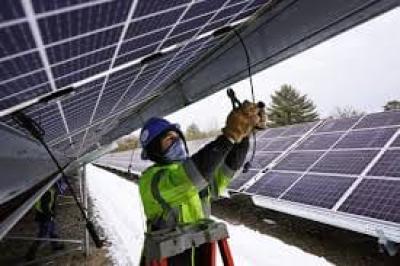Properties Lose Value in unregulated Solar Gold Rush in New Zealand
The sudden advent of scores of solar generating schemes on flat land close to electricity sub stations has reduced the value of nearby residential properties.
This is because real estate agents are required to notify buyers of the solar schemes and their documentation is tagged accordingly.
Estimates of the reduced value are said to be in the region of 30 percent.
An additional problem for residential property owners is that due to fast tracking by the Labour government these industrial solar schemes are largely unregulated.
Examples are end-to-end schemes close to schools and hospitals which are banned in other countries.
This fast tracking has largely overlooked the dangers of fire, and also the contamination problem of these schemes being built over water tables.
International finance companies are pouring into New Zealand to take advantage of what electricity supply officials describe as a gold rush.
These financiers include BlackRock of the United States and Germany’s Aquila Group.
The solar scheme developers are from Australia, Britain the United States and Ireland.
They are all ardently canvassing farmers with flatland close to substations in order to establish solar power station farm leases.
The major political parties Labour, National and ACT remain silent on this.
This is because they believe themselves to be dependent on the urban backing of activists in professional occupations with their taxpayer-subsidised electric cars.
The drop in value caused by solar generator designations hits hard especially those who have moved to rural communities as part of the Covid work from home campaign.
An unregulated aspect is the capacity of these solar generating plants which are scheduled to deliver to the national grid perhaps 175MW apiece and do so without being classified as industrial utilities.
Encouraged by these open fields close to substation connections the developers are free to install these projects over fertile flat land and close to residences and even whole communities.
The absence of restrictive regulations means also that they can be installed close to high value agribusiness export centres and also tourist areas.
An example of this is the back-to-back generating schemes planned for the Martinborough district and which will amount to 1000 acres of farm land with over half a million photovoltaics with battery structures and switching plants.
These assemblies are 15 feet tall and will dominate this high value tourist and viticulture district.
The absence of any regulation combined with the rush-to-install means that a number of elements are being deliberately ignored.
These include the fire risk experienced overseas and also the difficulty once the 30 year leases expire of remediating the pasture underlying the equipment which is mainly manufactured in China
Undefined is the question of who will be responsible for removing these immense installations either before or at the end of their generating life.
One developer alone is now well into establishing 11 solar stations throughout New Zealand. This is the Australian based Far North which is backed by Germany’s Aquila Group.
A similar number of generating stations is anticipated under BlackRock which was so enthusiastically ushered into New Zealand by the Labour government.
Notable reasons why real estate agents are required to formally document the hazards of these power installations which in the absence of regulation are planned for residential areas include:-
- Danger of fire
- Contamination to aquifers, water tables caused by the toxic components of the equipment which also requires chemical spraying.
- Vulnerability of the building-sized arrays to cyclone-scale wind
- Disposal of generating equipment at any time
- Visual dominance because existing trees are cleared for maximum sunlight exposure for the equipment.

